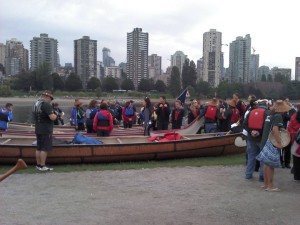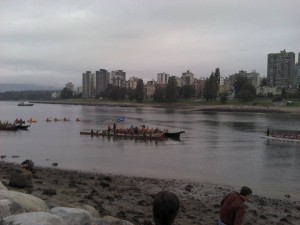Sep 29 | A Song of Flame
This is the first of three entries I’ve written during the events of the TRC. This one gives my account of Tuesday, September 29th, and the canoe procession.
 On the way to Vanier Park the sky is pearly grey, the air cool and damp. After weeks of warmth and sunshine it’s finally starting to feel like fall.
On the way to Vanier Park the sky is pearly grey, the air cool and damp. After weeks of warmth and sunshine it’s finally starting to feel like fall.
Through breaks in the trees I see flashes of red – the lifejackets and sweaters of those who gather near the marina. There are people of all colours milling around in their “Namwayut†T-shirts. The atmosphere is both cheerful and relaxed. Everyone is smiling, taking pictures, running back and forth for muffins and coffee.
I see six of my VST colleagues suited up to row with the Kairos canoe. We get our pictures taken, goof around, munch apples and croissants.
They eventually head off to bring the boat into the water. I continue on back toward the mountains and stop to stand above the rocky outcrop overlooking the channel which passes underneath the three bridges. Across from me is Sunset Beach, and I see a few curious onlookers on the piles of rocks leading down into the sea.
 I hear chanting from one of the teams still waiting on the shore. Voices also drift up from the water and canoes below. I see one group of four or five canoes packed tight together side by side, almost as though they were one big multi-leveled boat. One man stands at the stern with a megaphone and chants from what must be the very bottom of his feet. As he sings, the others in the boat sing along, sometimes rapping their oars on the bottom of the boat. A flag at the stern tells me this canoe belongs to the Songhees Nation.
I hear chanting from one of the teams still waiting on the shore. Voices also drift up from the water and canoes below. I see one group of four or five canoes packed tight together side by side, almost as though they were one big multi-leveled boat. One man stands at the stern with a megaphone and chants from what must be the very bottom of his feet. As he sings, the others in the boat sing along, sometimes rapping their oars on the bottom of the boat. A flag at the stern tells me this canoe belongs to the Songhees Nation.
Some of the boats are painted with animals in a traditional Coast Salish style. I see a lot of salmon, maybe a bear and a beaver or two. Some canoes look like the ones you might see at camp or in the movies, with the ends turned up like an elf’s shoe. Others have long prows which jut out from the bows like a pointing finger.
I see a smaller canoe move along the water, smooth as silk, carrying two elders who wear beautiful feathered headdresses, all in red, black, white, even purple and pink. Another boat holds a pack of college aged kids who trade a chant back and forth.
As time goes on more and more of the boats on the grass around me are lifted up and taken to the water. A First Nations man next to me comments that he is glad to see canoes modelled on the old birchwood boats that people from the Interior traditionally used.
I ask him what kind of boats the Musqueam use. After a pause, he says dryly, “Motorized boats.†We laugh.
I also ask him how the Songhees boats manage to stay so close together. “Are they hooked onto each other, or do they just hold on with their hands?â€
 “They’re just holding on,†he replied. “They’re all one people.â€
“They’re just holding on,†he replied. “They’re all one people.â€
We stand in silence for a bit, and then as he leaves and says goodbye, he touches my shoulder.
As I continue to watch, one boat goes by with the rowers decked out in red. As they pass, they lift their oars up and shake them. The oars are painted with red stripes that look like hands.
From where I stand, they look like tongues of flame, and I think of the Holy Spirit, and a wind granting speech. Today, I think that speech will sound like tongues that are rarely heard, tongues retained by strong grandparents and prophetically wilful children. I think of the many nations that I later see in their canoes in front of Science World, welcomed, treasured, and held – like buttons on a button blanket, each necessary to complete an image that will convey power, status, and proud, un-hidden identity.
“When the god of human self-confidence is found wanting, the God of the cross finds room.â€
–Brian Thorpe (From “Transformation in the Encounter: Reflections on a Dispute Resolution Process.†Touchstone Journal, Vol. 24 Number 2, May 2006).